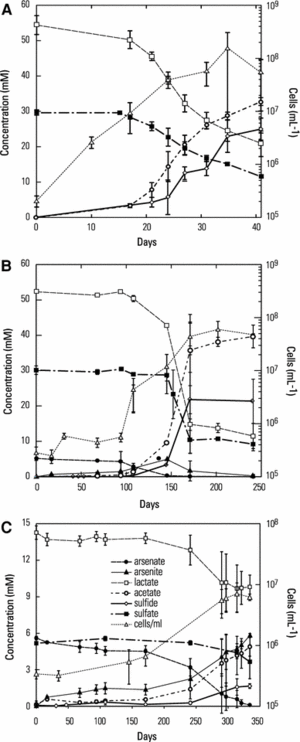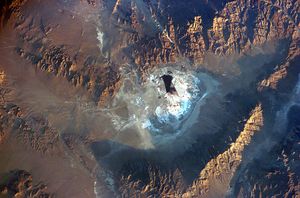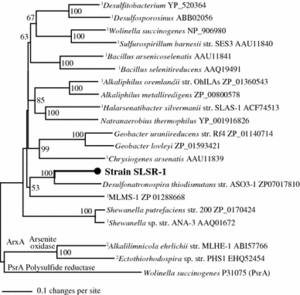Desulfohalophilus alkaliarsenatis: Difference between revisions
| Line 45: | Line 45: | ||
''D. alkaliarsenatis'' has unique metabolic characteristics. The electron donors consist of lactate or pyruvate, but not acetate. Growth was observed when sulfide served as the electron donor and nitrate served as the electron acceptor. Additionally, ''D. alkaliarsenatis'' demonstrated slow but obvious growth as an anaerobic heterotoph when cultivated in a defined mineral medium with sulfate. The strain SLSR-1 showed arsenate reduction was impeded modestly at the highest salinity tested (~330 g/L). | ''D. alkaliarsenatis'' has unique metabolic characteristics. The electron donors consist of lactate or pyruvate, but not acetate. Growth was observed when sulfide served as the electron donor and nitrate served as the electron acceptor. Additionally, ''D. alkaliarsenatis'' demonstrated slow but obvious growth as an anaerobic heterotoph when cultivated in a defined mineral medium with sulfate. The strain SLSR-1 showed arsenate reduction was impeded modestly at the highest salinity tested (~330 g/L). | ||
Most notably, within anoxic sediment, low but detectable free sulfide was prevalent below the dense brine water. Therefore, in the absence of sulfate, the origin of sulfide could arise from dissimilatory reduction of less oxidized intermediates of the sulfur cycle (i.e. thiosulfate, sulfite, or elemental sulfur.) | Most notably, within anoxic sediment, low but detectable free sulfide was prevalent below the dense brine water. Therefore, in the absence of sulfate, the origin of sulfide could arise from dissimilatory reduction of less oxidized intermediates of the sulfur cycle (i.e., thiosulfate, sulfite, or elemental sulfur.) | ||
==Ecology and Pathogenesis== | ==Ecology and Pathogenesis== | ||
Revision as of 13:35, 22 April 2013
Classification
Domain: Bacteria;
Phylum:Proteobacteria;
Class: Deltaproteobacteria;
Order:Desulfobacterales;
Family: Desulfohalobiaceae
Genus: Desulfohalophilus
Species: alkaliarsenatis
[Others may be used. Use NCBI link to find]
Species
Desulfohalophilus alkaliarsenatis
|
NCBI: Taxonomy |
Description and Significance
D. alkaliarsenatis is best described as an anaerobic, haloalkaliphilic bacteria. The SLSR-1 strain morphology is a motile vibrio that stain Gram-negative. The size of the bacteria is roughly .5 x 3.0μm, while TEM revealed the motility was due in part of a 10 μm polar flagellum. The preferred habitat of D. alkaliarsenatis is located in Searles Lake in CA, USA due in part to the high salt content and basic pH. It has demonstrated growth capability via sulfate-reduction over a broad range of salinities (50-300g/L). Most notably it is capable of growth via dissimilatory arsenate reduction which can make it of potential importance in that arsenate can inhibit the conversion of pyruvate into acetyl-CoA, blocking the Krebs cycle and therefore resulting in loss of ATP. Searles Lake is the optimum habitat because of the high arsenate.
Genome Structure
Little is known of the specific genome (i.e circular genome several genes that contribute to the Genes involved in sulfate reduction are (dsrAB) and arsenate respiration (arrA). Amplicons from 16S rRNA exhibited presence of close relatives of strain SLSR-1 as part of the flora of this ecosystem despite the fact that sulfate-reduction activity could not be detected in situ. Genetically, D. alkaliarsenatis is related closest to 3 other species of the Desulfonatronospira family: D.spira thiodismutans (95 %), D.spira delicata (94 %) and D.spira dismutans (94 %). The SLSR-1 partial ArrA was most similar to an ArrA-like encoding gene found in the genome of Desulfonatronospira thiodismutans (71 and 82 % amino acid identity and similarity, respectively)
Cell Structure, Metabolism and Life Cycle
The cell membrane is gram negative, containing a double outer membrane. The phospho-lipid fatty acids (PLFAs) make up the majority of the membrane. The most prominent of these being saturated fatty acids (44.8% of membrane) and the second most being branched/saturated (29.5% of membrane). Moreover, replication occurs via binary fission.
D. alkaliarsenatis has unique metabolic characteristics. The electron donors consist of lactate or pyruvate, but not acetate. Growth was observed when sulfide served as the electron donor and nitrate served as the electron acceptor. Additionally, D. alkaliarsenatis demonstrated slow but obvious growth as an anaerobic heterotoph when cultivated in a defined mineral medium with sulfate. The strain SLSR-1 showed arsenate reduction was impeded modestly at the highest salinity tested (~330 g/L).
Most notably, within anoxic sediment, low but detectable free sulfide was prevalent below the dense brine water. Therefore, in the absence of sulfate, the origin of sulfide could arise from dissimilatory reduction of less oxidized intermediates of the sulfur cycle (i.e., thiosulfate, sulfite, or elemental sulfur.)
Ecology and Pathogenesis

As a haloalkaliphilic sulfate-respiring bacterium, the biogeochemical significance of this organism is quite useful. The isolate is capable of grwoth via sulfate-reduction over a broad range of salinities (125-330g/L). Strain SLSR-1 was capable of growth primarily via dissimilatory arsenate-reduction and showed a broader range of salinity tolerance (50-330 g/L) while also growing under dissimilatory nitrate redution to ammonia. Because of the presence of borate found in Searles Lake, this limits the ability of the organism to respire via sulfate redcution, leaving arsenate reduction as its primary biogeochemical contribution.
Because little is still known of this organism, it is not yet determined if this bacterium participates in a symbiotic relationship as well as if it is pathogenic to humans, animals, or plants.
References
Author
Page authored by David Harsini and Torin Kulhanek, students of Prof. Jay Lennon at Michigan State University.
<-- Do not remove this line-->


